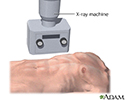Multimedia Gallery





Hip joint replacement - series
Hip joint replacement - Series
The hip joint is made up of two major parts: the hip socket (a part of the pelvic bone called the acetabulum) and the beginning part of the thighbone (called the femur).
Hip joint replacement - series
Hip joint replacement - Series
The hip joint is made up of two major parts: the hip socket (a part of the pelvic bone called the acetabulum) and the beginning part of the thighbone...
Hip joint replacement - series
Indications
Osteoarthritis is the most common disease of the hip. It is caused by wear and tear on the joint. Cartilage is the firm, rubbery tissue that cushions your bones and joints. It allows bones to glide over one another. Cartilage can break down and wear away. As a result, the bones rub together, causing pain, swelling, and stiffness.
The most common reason to have a hip joint replaced is relieve severe arthritis pain that limits what you can do. Hip joint replacement is usually done in people age 60 and older. This is because most artificial hips do not last more than 20 years. Also, younger people who have this surgery tend to place more strain on their new hip.
Hip joint replacement - series
Indications
Osteoarthritis is the most common disease of the hip. It is caused by wear and tear on the joint. Cartilage is the firm, rubbery tissue that cushions...
Hip joint replacement - series
Procedure, part 1
Hip joint replacement is surgery to replace all or part of the hip joint with a man-made or artificial joint. The artificial joint is called a prosthesis. The artificial hip joint has 4 parts:
- A socket that replaces your old hip socket. The socket is usually made of metal.
- A liner that fits inside the socket. It is usually plastic, but some surgeons use ceramic and metal. The liner allows the hip to move smoothly.
- A metal or ceramic ball that will replace the round head (top) of your thighbone.
- A metal stem that is attached to the shaft of the bone.
After you receive anesthesia, your surgeon will make an incision (cut) to open up your hip joint. Then your surgeon will:
- Remove the head of your thigh (femur) bone.
- Clean out your hip socket and remove the remaining cartilage and damaged or arthritic bone.
Hip joint replacement - series
Procedure, part 1
Hip joint replacement is surgery to replace all or part of the hip joint with a man-made or artificial joint. The artificial joint is called a prosth...
Hip joint replacement - series
Procedure, part 2
Next, the surgeon will:
- Put the new hip socket in place and insert the metal stem into your thighbone
- Check your hip's stability and place the correctly sized ball for the new joint
- Fix all the new parts in place, sometimes with a special cement
- Repair the muscles and tendons around the new joint
- Close the incision
A small drainage tube will be placed during surgery to help drain excess fluids from the joint area. A large dressing will cover to the hip area.
Hip joint replacement - series
Procedure, part 2
Next, the surgeon will:Put the new hip socket in place and insert the metal stem into your thighboneCheck your hip's stability and place the correctl...
Hip joint replacement - series
Aftercare
This surgery usually takes 1 to 3 hours. You will stay in the hospital for 3 to 5 days. Full recovery will take from 2 months to a year.
- Hip replacement surgery results are usually excellent. Most or all of the hip pain and stiffness should go away. Some people may have problems with infection, or even dislocation, of the new hip joint.
- Over time -- sometimes as long as 20 years -- the artificial hip joint will loosen. A second replacement may be needed.
- Younger, more active, people may wear out parts of their new hip. Their artificial hip may need to be replaced before it loosens. It is important to have scheduled follow-up visits with your surgeon every year to check the position of the implants.
By the time you go home, you should be able to walk with a walker or crutches without needing much help. Use your crutches or walker for as long as you need them. Most people do not need them after 2 to 4 weeks.
Keep moving and walking once you get home. Do not put weight on your side with the new hip until your doctor tells you it is okay. Start out with short periods of activity, and then gradually increase them. Your doctor or physical therapist will give you exercises to do at home.
Over time, you should be able to return to your former level of activity. You will need to avoid some sports, such as downhill skiing or contact sports like football and soccer. But you should be able to do low impact activities, such as hiking, gardening, swimming, playing tennis, and golfing.
Hip joint replacement - series
Aftercare
This surgery usually takes 1 to 3 hours. You will stay in the hospital for 3 to 5 days. Full recovery will take from 2 months to a year.Hip replaceme...
Review Date: 11/7/2024
Reviewed By: C. Benjamin Ma, MD, Professor, Chief, Sports Medicine and Shoulder Service, UCSF Department of Orthopaedic Surgery, San Francisco, CA. Also reviewed by David C. Dugdale, MD, Medical Director, Brenda Conaway, Editorial Director, and the A.D.A.M. Editorial team.
The hip joint is made up of two major parts: the hip socket (a part of the pelvic bone called the acetabulum) and the beginning part of the thighbone (called the femur).
Osteoarthritis is the most common disease of the hip. It is caused by wear and tear on the joint. Cartilage is the firm, rubbery tissue that cushions your bones and joints. It allows bones to glide over one another. Cartilage can break down and wear away. As a result, the bones rub together, causing pain, swelling, and stiffness.
The most common reason to have a hip joint replaced is relieve severe arthritis pain that limits what you can do. Hip joint replacement is usually done in people age 60 and older. This is because most artificial hips do not last more than 20 years. Also, younger people who have this surgery tend to place more strain on their new hip.
Hip joint replacement is surgery to replace all or part of the hip joint with a man-made or artificial joint. The artificial joint is called a prosthesis. The artificial hip joint has 4 parts:
- A socket that replaces your old hip socket. The socket is usually made of metal.
- A liner that fits inside the socket. It is usually plastic, but some surgeons use ceramic and metal. The liner allows the hip to move smoothly.
- A metal or ceramic ball that will replace the round head (top) of your thighbone.
- A metal stem that is attached to the shaft of the bone.
After you receive anesthesia, your surgeon will make an incision (cut) to open up your hip joint. Then your surgeon will:
- Remove the head of your thigh (femur) bone.
- Clean out your hip socket and remove the remaining cartilage and damaged or arthritic bone.
Next, the surgeon will:
- Put the new hip socket in place and insert the metal stem into your thighbone
- Check your hip's stability and place the correctly sized ball for the new joint
- Fix all the new parts in place, sometimes with a special cement
- Repair the muscles and tendons around the new joint
- Close the incision
A small drainage tube will be placed during surgery to help drain excess fluids from the joint area. A large dressing will cover to the hip area.
This surgery usually takes 1 to 3 hours. You will stay in the hospital for 3 to 5 days. Full recovery will take from 2 months to a year.
- Hip replacement surgery results are usually excellent. Most or all of the hip pain and stiffness should go away. Some people may have problems with infection, or even dislocation, of the new hip joint.
- Over time -- sometimes as long as 20 years -- the artificial hip joint will loosen. A second replacement may be needed.
- Younger, more active, people may wear out parts of their new hip. Their artificial hip may need to be replaced before it loosens. It is important to have scheduled follow-up visits with your surgeon every year to check the position of the implants.
By the time you go home, you should be able to walk with a walker or crutches without needing much help. Use your crutches or walker for as long as you need them. Most people do not need them after 2 to 4 weeks.
Keep moving and walking once you get home. Do not put weight on your side with the new hip until your doctor tells you it is okay. Start out with short periods of activity, and then gradually increase them. Your doctor or physical therapist will give you exercises to do at home.
Over time, you should be able to return to your former level of activity. You will need to avoid some sports, such as downhill skiing or contact sports like football and soccer. But you should be able to do low impact activities, such as hiking, gardening, swimming, playing tennis, and golfing.





Animations
- Ankle ligament injury
- Ankylosing spondylitis
- Anterior shoulder stretch
- Arm reach
- Arthritis
- Bone fracture repair
- Bunion
- Carpal tunnel syndrome
- Exercise
- External rotation with band
- Fibromyalgia
- Foot pain
- Heel pain
- Herniated disk
- Herniated nucleus pulposus ...
- Hip joint replacement
- How to use a pill cutter
- Internal rotation with band
- Isometric
- Knee joint replacement
- Multiple sclerosis
- Neck pain
- Osteoarthritis
- Osteoarthritis
- Osteoporosis
- Osteoporosis
- Pendulum exercise
- Plantar fasciitis
- Rheumatoid arthritis
- Rotator cuff problems
- Sciatica
- Scoliosis
- Shoulder blade retraction
- Shoulder blade retraction w...
- Shoulder joint dislocation
- Shoulder pain
- Spinal stenosis
- Stretching back of your shoulder
- Up the back stretch
- Vacation health care
- Wall push-up
- Wall stretch
- What is tennis elbow?
Illustrations
- ACL degrees
- ACL injury
- Active vs. inactive muscle
- Aerobic exercise
- Ankle anatomy
- Ankle sprain
- Ankle sprain swelling
- Anterior cruciate ligament ...
- Anterior skeletal anatomy
- Arthritis in hip
- Aseptic necrosis
- Baker cyst
- Benefit of regular exercise
- Blood supply to bone
- Blood test
- Bone biopsy
- Bone density scan
- Bone graft harvest
- Bone tumor
- Bone-building exercise
- Bursa of the elbow
- Bursa of the knee
- Bursitis of the shoulder
- Calcium benefit
- Calcium source
- Calculating body frame size
- Calories and fat per serving
- Carpal biopsy
- Carpal tunnel surgical procedure
- Carpal tunnel syndrome
- Cauda equina
- Central nervous system
- Central nervous system and ...
- Cervical spondylosis
- Cervical vertebrae
- Changes in spine with age
- Chest stretch
- Chondromalacia of the patella
- Clubfoot deformity
- Colles fracture
- Common peroneal nerve dysfu...
- Compression fracture
- Compression of the median nerve
- Congenital hip dislocation
- Contracture deformity
- Corns and calluses
- CREST syndrome
- CT scan
- Damaged axillary nerve
- Dislocation of the hip
- Early treatment of injury
- Elbow - side view
- Electromyography
- Ewing sarcoma - x-ray
- Exercise - a powerful tool
- Exercise and age
- Exercise and heart rate
- Exercise can lower blood pr...
- Exercise with friends
- External fixation device
- Fast food
- Femoral fracture
- Femoral nerve damage
- Fibromyalgia
- Fish in diet
- Foot swelling
- Forward bend test
- Fracture types (1)
- Fracture types (2)
- Fracture, forearm - x-ray
- Fractures across a growth plate
- Groin stretch
- Hammer toe
- Hamstring stretch
- Head trauma
- Healthy diet
- Herniated disk repair
- Herniated lumbar disk
- Herniated nucleus pulposus
- Hip fracture
- Hip stretch
- Hunger center in brain
- Hypermobile joints
- Impingement syndrome
- Inflamed Achilles tendon
- Inflamed shoulder tendons
- Internal fixation devices
- Intervertebral disk
- Isometric exercise
- Joint aspiration
- Knee arthroscopy
- Knee joint
- Knee joint replacement pros...
- Knee pain
- Kyphosis
- Lateral collateral ligament
- Lateral collateral ligament...
- Lateral collateral ligament pain
- Leg pain (Osgood-Schlatter)
- Leg skeletal anatomy
- Limited range of motion
- Location of whiplash pain
- Lordosis
- Lower leg edema
- Lower leg muscles
- Lower leg muscles
- Lumbar vertebrae
- Lupus - discoid on a child'...
- Lupus - discoid on the face
- Lupus, discoid - view of l...
- Medial collateral ligament
- Medial collateral ligament ...
- Medial collateral ligament pain
- Meniscal tears
- Metatarsus adductus
- MRI scans
- Muscle biopsy
- Muscle cells vs. fat cells
- Muscle pain
- Muscle strain
- Muscular atrophy
- myPlate
- Neck pain
- Nerve biopsy
- Nerve conduction test
- Normal foot x-ray
- Normal knee anatomy
- Nuclear scan
- Osteoarthritis
- Osteoarthritis
- Osteoarthritis vs. rheumato...
- Osteogenic sarcoma - x-ray
- Osteomyelitis
- Osteoporosis
- Osteoporosis
- Patellar dislocation
- Physical activity - prevent...
- Plantar fascia
- Plantar fasciitis
- Posterior cruciate ligament...
- Posterior spinal anatomy
- Psoriasis - guttate on the ...
- Psoriasis - guttate on the cheek
- Radial head injury
- Radial nerve dysfunction
- Raynaud's phenomenon
- Reactive arthritis - view o...
- Retrocalcaneal bursitis
- Rheumatoid arthritis
- Rheumatoid arthritis
- Rheumatoid arthritis
- Rheumatoid arthritis
- Rotator cuff muscles
- Runners knee
- Sacrum
- Sciatic nerve
- Sciatic nerve damage
- Sclerodactyly
- Scoliosis
- Scoliosis
- Scoliosis brace
- Shin splints
- Shoulder arthroscopy
- Shoulder joint
- Shoulder joint inflammation
- Shoulder sling
- Signs of scoliosis
- Skeletal spine
- Skeleton
- Smashed fingers
- Spinal anatomy
- Spinal cord injury
- Spinal curves
- Spinal fusion
- Spinal stenosis
- Spinal stenosis
- Spinal tumor
- Spine supporting structures
- Sprained ankle
- Superficial anterior muscles
- Surface anatomy - normal palm
- Surface anatomy - normal wrist
- Synovial biopsy
- Synovial fluid
- Systemic lupus erythematosus
- Systemic lupus erythematosu...
- Tailbone (coccyx)
- Telangiectasia
- Tendinitis
- Tendon vs. ligament
- Tendonitis
- Tendons and muscles
- The structure of a joint
- Thigh stretch
- Tibial nerve
- Tophi gout in hand
- Torn lateral collateral ligament
- Torn medial collateral ligament
- Torticollis (wry neck)
- Treatment for leg strain
- Triangular shoulder sling
- Triceps stretch
- Ulnar nerve damage
- Uric acid crystals
- Vertebra, cervical (neck)
- Vertebra, lumbar (low back)
- Vertebra, thoracic (mid back)
- Vertebrae
- Vertebral column
- Vitamin D source
- Weight loss
- Whiplash
- Wrist anatomy
- Wrist splint
- X-ray
- X-ray
- Yo-yo dieting
Presentations
- Ankle sprain - Series
- Anterior cruciate ligament ...
- Bone fracture repair - series
- Bunion removal - series
- Carpal tunnel repair - series
- Clubfoot repair - series
- Creating a sling - series
- Hand splint - series
- Hip joint replacement - series
- Knee arthroscopy - series
- Knee joint replacement - series
- Leg lengthening - series
- Lumbar spinal surgery - series
- Microdiskectomy - series
- Partial knee replacement - ...
- Rotator cuff repair - series
- Shoulder separation - series
- Spinal bone graft - series
- Spinal fusion - series
- Spinal surgery - cervical -...
- Two person roll - series

 Bookmark
Bookmark


























































































































































































































































































